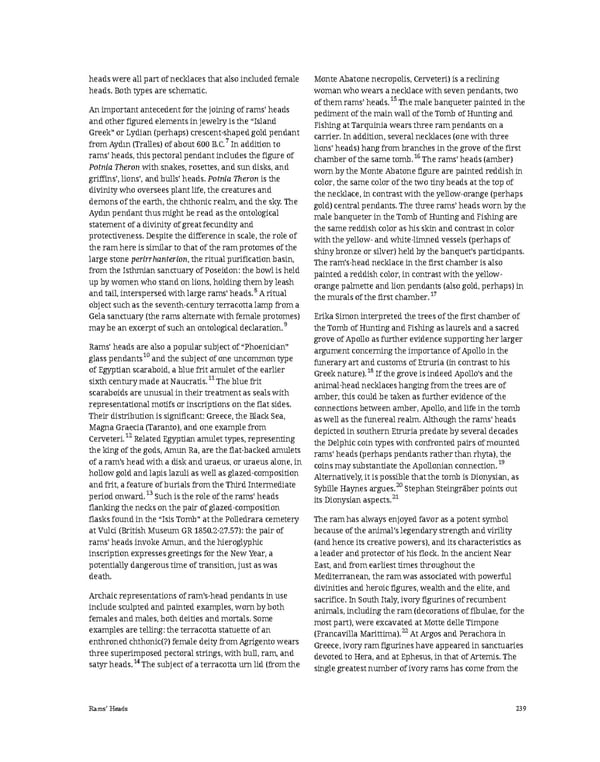heads were all part of necklaces that also included female Monte Abatone necropolis, Cerveteri) is a reclining heads. Both types are schematic. woman who wears a necklace with seven pendants, two of them rams’ heads.15 The male banqueter painted in the An important antecedent for the joining of rams’ heads pediment of the main wall of the Tomb of Hunting and and other figured elements in jewelry is the “Island Fishing at Tarquinia wears three ram pendants on a Greek” or Lydian (perhaps) crescent-shaped gold pendant carrier. In addition, several necklaces (one with three from Aydın (Tralles) of about 600 B.C.7 In addition to lions’ heads) hang from branches in the grove of the first rams’ heads, this pectoral pendant includes the figure of chamber of the same tomb.16 The rams’ heads (amber) Potnia Theron with snakes, rosettes, and sun disks, and worn by the Monte Abatone figure are painted reddish in griffins’, lions’, and bulls’ heads. Potnia Theron is the color, the same color of the two tiny beads at the top of divinity who oversees plant life, the creatures and the necklace, in contrast with the yellow-orange (perhaps demons of the earth, the chthonic realm, and the sky. The gold) central pendants. The three rams’ heads worn by the Aydın pendant thus might be read as the ontological male banqueter in the Tomb of Hunting and Fishing are statement of a divinity of great fecundity and the same reddish color as his skin and contrast in color protectiveness. Despite the difference in scale, the role of with the yellow- and white-limned vessels (perhaps of the ram here is similar to that of the ram protomes of the shiny bronze or silver) held by the banquet’s participants. large stone perirrhanterion, the ritual purification basin, The ram’s-head necklace in the first chamber is also from the Isthmian sanctuary of Poseidon: the bowl is held painted a reddish color, in contrast with the yellow- up by women who stand on lions, holding them by leash orange palmette and lion pendants (also gold, perhaps) in and tail, interspersed with large rams’ heads.8 A ritual 17 the murals of the first chamber. object such as the seventh-century terracotta lamp from a Gela sanctuary (the rams alternate with female protomes) Erika Simon interpreted the trees of the first chamber of may be an excerpt of such an ontological declaration.9 the Tomb of Hunting and Fishing as laurels and a sacred grove of Apollo as further evidence supporting her larger Rams’ heads are also a popular subject of “Phoenician” argument concerning the importance of Apollo in the glass pendants10 and the subject of one uncommon type funerary art and customs of Etruria (in contrast to his of Egyptian scaraboid, a blue frit amulet of the earlier Greek nature).18 If the grove is indeed Apollo’s and the sixth century made at Naucratis.11 The blue frit animal-head necklaces hanging from the trees are of scaraboids are unusual in their treatment as seals with amber, this could be taken as further evidence of the representational motifs or inscriptions on the flat sides. connections between amber, Apollo, and life in the tomb Their distribution is significant: Greece, the Black Sea, as well as the funereal realm. Although the rams’ heads Magna Graecia (Taranto), and one example from depicted in southern Etruria predate by several decades Cerveteri.12 Related Egyptian amulet types, representing the Delphic coin types with confronted pairs of mounted the king of the gods, Amun Ra, are the flat-backed amulets rams’ heads (perhaps pendants rather than rhyta), the of a ram’s head with a disk and uraeus, or uraeus alone, in coins may substantiate the Apollonian connection.19 hollow gold and lapis lazuli as well as glazed-composition Alternatively, it is possible that the tomb is Dionysian, as and frit, a feature of burials from the Third Intermediate Sybille Haynes argues.20 Stephan Steingräber points out period onward.13 Such is the role of the rams’ heads 21 its Dionysian aspects. flanking the necks on the pair of glazed-composition flasks found in the “Isis Tomb” at the Polledrara cemetery The ram has always enjoyed favor as a potent symbol at Vulci (British Museum GR 1850.2-27.57): the pair of because of the animal’s legendary strength and virility rams’ heads invoke Amun, and the hieroglyphic (and hence its creative powers), and its characteristics as inscription expresses greetings for the New Year, a a leader and protector of his flock. In the ancient Near potentially dangerous time of transition, just as was East, and from earliest times throughout the death. Mediterranean, the ram was associated with powerful divinities and heroic figures, wealth and the elite, and Archaic representations of ram’s-head pendants in use sacrifice. In South Italy, ivory figurines of recumbent include sculpted and painted examples, worn by both animals, including the ram (decorations of fibulae, for the females and males, both deities and mortals. Some most part), were excavated at Motte delle Timpone examples are telling: the terracotta statuette of an (Francavilla Marittima).22 At Argos and Perachora in enthroned chthonic(?) female deity from Agrigento wears Greece, ivory ram figurines have appeared in sanctuaries three superimposed pectoral strings, with bull, ram, and devoted to Hera, and at Ephesus, in that of Artemis. The satyr heads.14 The subject of a terracotta urn lid (from the single greatest number of ivory rams has come from the Rams’ Heads 239
 Ancient Carved Ambers in the J. Paul Getty Museum Page 248 Page 250
Ancient Carved Ambers in the J. Paul Getty Museum Page 248 Page 250